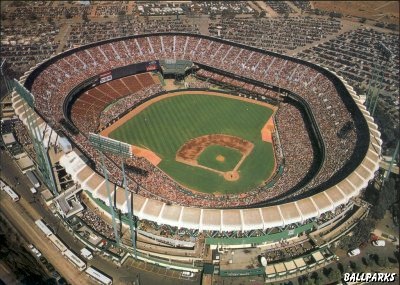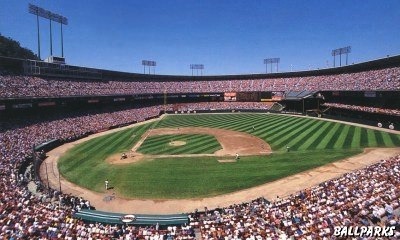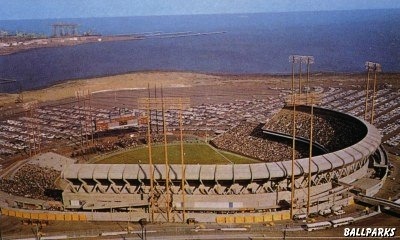Candlestick Park
A.K.A. 3Com Park & Monster Park San Francisco, CaliforniaTenants: San Francisco Giants (NL); San Francisco 49ers (NFL) Architect: John Bolles; Chin and Hensolt (engineers) San Francisco Giants tickets:
Location: In the southeast corner of San Francisco at Candlestick point. Left field (NW), Giants Drive; third base (SW), Jamestown Avenue and Bay View Hill; first base (SE), Jamestown Avenue, Candlestick Point, and San Francisco; right field (NE), Hunters Point Expressway and San Francisco Bay. Dimensions: Left field: 330 (1960), 335 (1968); left-center: 397 (1960), 365 (1961); center field: 420 (1960), 410 (1961), 400 (1982); right-center: 397 (1960), 365 (1961), 365 (1982); right field: 330 (1965), 335 (1968), 330 (1991), 328 (1993); backstop: 73 (1960), 70 (1961), 55 (1975), 65 (1982), 66 (1985); foul territory: very large. Fences: 10 (wire, 1960); 8 (wire, 1972); 12 (6 canvas below 6 plexiglass, 1975); 9 (6 canvas below 3 plexiglass, 1982); 9 (wire, 1984), 9.5 (fence posts, 1984); 8 (canvas, 1993).
On a beautiful morning in 1957, San Francisco Mayor Christopher showed New York Giants owner Horace Stoneham around Candlestick Point, the projected site for a Giants ballpark. What the Mayor knew and, presumably, Stoneham didn't was that although Candlestick Point can be lovely on a summer morning, it is usually one of the coldest, windiest and foggiest places in the country on a summer night. Fog rolls in over parts of San Francisco on most summer evenings and Candlestick Park was built in one of those parts. During the 1961 All Star game, Giants pitcher Stu Miller was blown off the mound and, in 1963, New York Mets Manager Casey Stengel took his squad out for batting practice, only to watch a gust of wind pick up the entire batting cage and drop it 60 feet away on the pitcher’s mound. Willie Mays led the league in home runs three times while playing half his games at "the 'Stick." However, the wind always blows in from left field there, and many people think Mays would have hit 800 homers if he’d played somewhere else. Lefthanded hitters, on the other hand, got the benefit of the "jetstream" to right. Although Candlestick Park was built for the Giants, the Beatles played their last concert ever there on August 29, 1966, and the NFL’s 49ers have won so many Super Bowls since they moved there in 1971 that the sign in the parking lot said, "Home of the Super Bowl Champions," with almost no mention of the primary tenants. Richard Nixon threw out the first ball at the first game ever at the 'Stick, on April 12, 1960, then proclaimed it "the finest ballpark in America." Bill White, who later became the National League president, got the first hit there. The Giants' Gaylord Perry and Cardinals' Ray Washburn threw no-hitters there on the same weekend - on September 17 and 18, 1968. The Los Angeles Dodgers and the Giants staged a memorable playoff for the National League pennant there in 1962, complete with a controversy over the Giants watering down the infield to slow down basestealer extraordinaire Maury Wills. Mays broke the all-time National League home run record at Candlestick Park on May 4, 1966, and he got his 3,000th hit there on July 18, 1971.
Six World Series games have been played at Candlestick Park, but the most memorable October event there was the World Series game that wasn’t played. That was on October 17, 1989, when an earthquake measuring 7.1 on the Richter Scale preempted what was to have been Game 3 of the 1989 Bay Bridge World Series against the Oakland A’s. As houses crumbled, highways buckled and bridges collapsed, Candlestick Park stood strong - with 62,000 people packed inside it, none of whom were injured. In 1993, under a new group of owners led by former Safeway head Peter Magowan, some significant changes were made to the park to make it more fan friendly. More games were played during the day, the food was improved and a new bleacher section was built in left field which was closer to the action. Trivia:
More on Candlestick Park: Recommended Reading (bibliography):
Help us provide a better web site by completing our feedback form PHOTOGRAPHS: Aerial view of Candlestick Park © 1999 by Mike Smith. Updated July 2007 Tickets to MLB All Star game, NCAA Basketball Tournament, College Football Bowl, NCAA Football, San Francisco 49ers, Paul McCartney and San Francisco Giants provided by Ticket Triangle. BALLPARKS © 1996-2014 by Munsey & Suppes.
|








